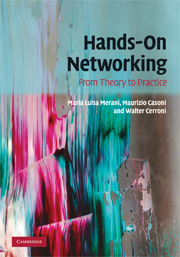3 - Ethernet networks
Published online by Cambridge University Press: 05 June 2012
Summary
The initial focus of this chapter is on the most significant issue to solve in the MAC sublayer of LANs and MANs: how to allow a given number of stations to share a common channel to communicate. Among the different solutions that can be devised, the answer successfully adopted by current LANs is introduced and critically commented on.
Such treatment is followed by a description of the general IEEE framework where LAN and MAN standards sit. There finds its place the standard for the implementation of Ethernet LANs, also known as the IEEE 802.3 standard, whose physical layer and MAC sublayer specifications are faced next. An adequate coverage is provided for the admissible topologies, MAC frame format and main algorithms; the evolution that this type of LAN has undergone in the last years is also illustrated, from the original solutions to fast and current gigabit Ethernet networks.
What follows is a description of the reference standards that modern cabling systems have to conform to. The intent is twofold: to make the reader understand (i) how crucial the cabling system is in guaranteeing a successfully operative network; (ii) how important its physical properties are when striving to support higher and higher data rates.
The chapter is closed by a few dense practices, which aim at explaining several real-world issues: the relation between layer-3 and layer-2 addressing schemes; the configuration of the hardware device that allows the station to connect to the LAN and to the Internet; and the layout of the cabling system for a campus network.
- Type
- Chapter
- Information
- Hands-On NetworkingFrom Theory to Practice, pp. 61 - 96Publisher: Cambridge University PressPrint publication year: 2009



